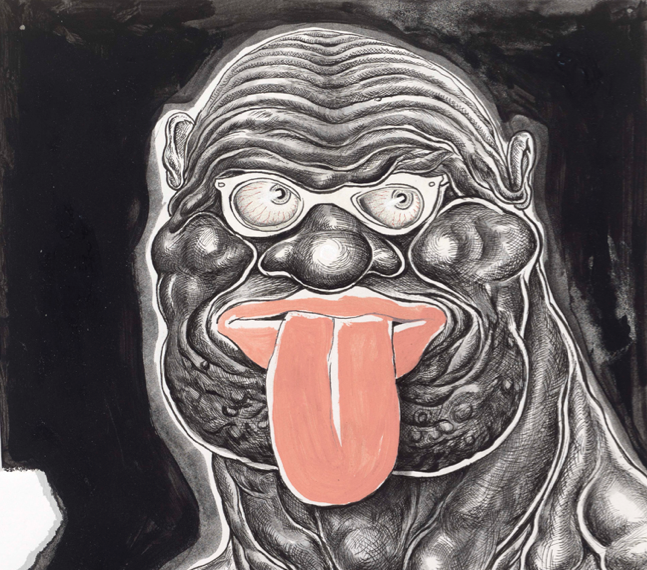
Trenton Doyle Hancock, Self-Portrait with Tongue, 2010
A “messy, wild, irreverent joy,” Trenton Doyle Hancock’s traveling retrospective at the Studio Museum Harlem, Skin and Bones, pulls viewers into the artist’s surreal imagination and traces the evolution of his alter ego, Torpedo Boy, from “aspirational self-portrait” to a now “more down-and-out” character. “He’s very flawed,” Hancock says. “I’m sometimes terribly ashamed that he is a part of me.”
- While much of the net.art from the 1990s has become obsolete, many pieces have stood the test of time, including Jodi.org whose web source info reveals a hidden set of “text-drawings”—proving that the markup language of a website is a work of art in itself.
- This summer, artist Nick Cave will lead a series of public performances and events throughout the metropolitan area of Detroit. Working with local dance troupes and musicians, Cave hopes to give something back to the city that he says, “saved his life.”
- Former MOCA director Jeffrey Deitch gave a frank defense of the institution’s much derided James Franco–curated show, comparing it to the Björk show at the MoMA, arguing that the art elite fears shows with mass appeal because they can’t “control the dialogue.”
- The iOS app version of Stan Douglas’s film Circa 1948 is less immersive than its original installation at Tribeca, but retains its noir mood, giving users a detailed, ghostly window into the lives of the denizens, both rich and poor, of 1940’s Vancouver. “There are 45 different stories you can find in Circa 1948 by clicking on illuminated objects, but there is no end and you’re not required to linger over any of the conversations that drag in ways similar to what you’d hear eavesdropping in the real world,” reports Hyperallergic.
- Nearly a third of the major solo shows held in US museums between 2007 and 2013 featured artists represented by five galleries, a new study of 600 shows at 68 museums finds. Museums “should be looking at a much wider swathe of artists,” says Yale’s Robert Storr.
- A certificate of authenticity is often the only record that gives value to a conceptual art work: if it’s lost, so is the work. And so it was, until recently: thanks to AIG Private Client Services and Crystal & Co. it’s now possible to insure conceptual art.
Follow Art News From Elsewhere on the Walker Art Center homepage or via @walkermag, the Walker’s editorial-focused Twitter feed.



